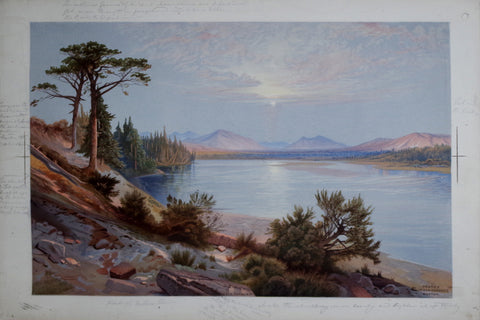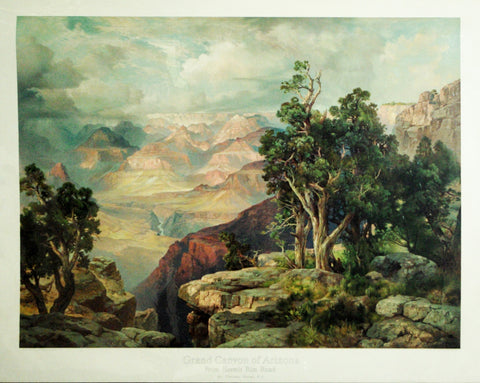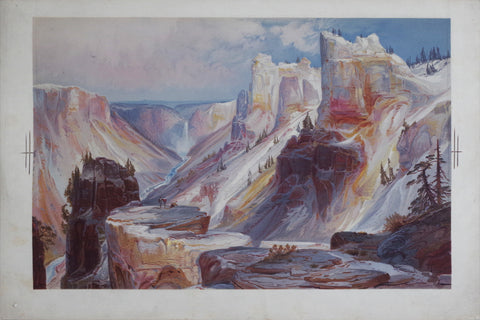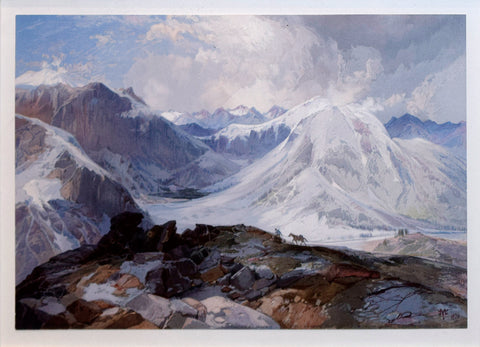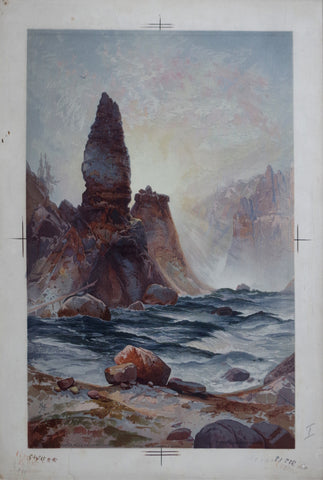Search By Artist
Thomas Moran (1837-1926)
Thomas Moran (1837-1926)
Yellowstone National Park
Boston: Louis Prang & Co., 1876
Chromolithographs
When the fifteen images of Thomas Moran's Yellowstone National Park were issued by Prang, The Times of London proclaimed that "no finer specimens of chromo-lithographic work have been produced anywhere." Each plate, titled and monogrammed "TYM", was mounted on heavy card, suitable for framing. Indeed, they made history even before they were finished.
In 1871, Moran joined F. V. Hayden's government expedition to the Yellowstone. No more suitable company could have been assembled. The leader of the expedition was Chief of the U. S. Geological Survey, the artist was one of the most eminent of Rocky Mountain School painters, and the photographer, William Henry Jackson, held a similar position among nineteenth-century pioneers of his art. For sixteen days, Moran sketched and William Henry Jackson photographed the most compelling features of what was to become Yellowstone National Park, from the impressive geothermal formations of geysers and hot springs to the vivid colors of the river canyon itself.
Hayden presented Moran's watercolors and Jackson's photographs to Congress as part of his successful effort to designate Yellowstone as America's first national park. The strategy worked. The pictures, even more than Hayden's oratory, revealed the scale and splendor of that still untouched landscape, persuading the legislators that it must be preserved, a decision that resulted in the establishment of the first national park. Proud of his role, Moran adopted a new signature: T-Y-M, Thomas "Yellowstone" Moran.
In addition to its historical significance, the Yellowstone portfolio was a technical tour-de-force. In his definitive book on chromolithography, Peter Marzio stated: "...each chromo is a masterpiece. This is Prang's greatest work and represents the high tide of chromolithography in America." Moran's painting technique, grounded by an apprenticeship in commercial printshops and refined by his admiration for Turner, was perfectly suited to the demands of color printing from stone, and he remains to this day one of the most gifted artists to have worked in the medium.
Born in Bolton, England, Moran immigrated to the United States in 1844. He received his first art instruction from his elder brother Edward, and later found employment as an illustrator in New York City. Moran was on assignment for Scribner's Magazine in 1871 when he was selected to accompany Ferdinand V. Hayden's geological survey to the headwaters of the Yellowstone River. The following year he visited California's Yosemite Valley and in 1873 joined John Wesley Powell's exploration of the Colorado River.
Moran published his views of the Far West in various periodicals and produced several large paintings, including The Great Canyon of the Yellowstone and Chasm in the Colorado, which were purchased by the U. S. Congress. Over the next forty years he traveled widely and many of his favorite sketching sites in the West were set aside as national parks and monuments, notably Yellowstone, Yosemite, and the Grand Canyon of the Colorado in Arizona. He was elected to the membership of the National Academy of Design in 1884 and produced a large body of work in his later years.
Moran was intimately in tune with the spirit of his age, and this, combined with his phenomenal artistic talent, accounts for much of his fame. To the great majority of people who did not have the resources or daring to travel, Moran provided an image of the American continent's infinite potential as symbolized by its dramatic, unique landscape. The English-born artist showed American expansion as a fated conclusion, a glorious destiny written into the very landscape of the young country. Moran's pictures resonate perhaps even more strongly today than at the time of their production. The optimism visible in his work echoes with the American experience of the rest of the twentieth century, and it is with increasing nostalgia for the nation's pioneer history that today's viewers regard the artist's work.

